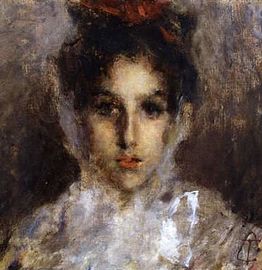Tranquillo Cremona

Tranquillo Cremona (10 April 1837 – 10 June 1878) was an Italian painter. His paintings have a windswept style, lacking the linearity of Francesco Hayez and other academics; reminiscent of the Venice School and Titian.
Biography
[edit]He was born in Pavia and was the brother of the mathematician Luigi Cremona. He trained as a young man with Giovanni Carnovali.[1] Others note he trained under a painter by the name of Giacomo Trecourt from Bergamo. He moved to Venice in 1852, where he lived alongside his brother, the lawyer Giacomo Cremona, until 1859.

His first major work was a large historic canvas Marco Polo At The Court of Kubla Khan (finished 1863), followed by il Falconieri (1865), and Lovers at the tomb of Juliet.[2] Cremona had moved to Milan and, influenced by his teacher Carnovali, became part of the Scapigliatura movement. It was characterized by bohemian attitudes, included poets, writers, musicians and artists, and was infused with a combination of rebellious tendencies. Later, it would become anti-academic and anarchic. Among Cremona's contemporaries in this movement were Giuseppe Rovani, Antonio Tantardini, Giuseppe Grandi, Ferdinando Fontana, and Daniele Ranzoni.
He painted numerous portraits, and his subjects were often women. Among his best-known are those of Emma Ivon, Vittore Grubicy, and Carlo Dossi. He also painted grand subjects such as Scenes from Goethe's Faust. His brushstrokes often create figures that appear to blend into their surroundings. His subject's actions often remain cryptic in meaning, other than a transient observation of human encounters and behaviors. His technique recalls the pittura de tocco e di macchia (painting of touch and dots) practiced by painters such as Titian, Rembrandt, and 18th-century Northern Italian baroque masters such as Giuseppe Maria Crespi, Francesco Guardi, Giovanni Battista Piazzetta, and Giuseppe Bazzani. Two of his works are in the Museo Cantonale d'Arte of Lugano.[3]
His painting titled La Melodia (1874, private collection) has a woman at a piano, in an impressionist style, face leaning partially away, challenging us to view the musical composition as the subject of the brushstrokes, instead of persons or dimensional objects.[4] In a work completed a few months before his death, L’edera (1878; Ivy, referring to a strand of the plant at the margin), one figure embraces passionately an aloof figure. The nature of the situation is not obvious.[5]
He was a friend of Scapigliatura writer Carlo Dossi. New editions of the works of the writers and poets of the Scapigliatura often feature Cremona's paintings on their covers. He died in Milan, at the age of 41, of a sudden intestinal ailment, attributed to intoxication by the oil pigments which he made himself, and which he usually tested by spreading them on the bare skin of his arms.[citation needed]
Selected paintings
[edit]-
Portrait of Luigi Luvoni (1872)
-
Melody
-
Repeating the Lesson (1876)
-
Marco Polo before the Grand Khan (1863)
-
The Curious Women (1877)
-
Sick Young Woman (1877)
-
Ivy (1878)
The male figure is the composer Alfredo Catalani
References
[edit]- ^ Tranquillo Cremona e la china pericolosa dei “periferici” dell’ Eurozona
- ^ Rivista enciclopedica contemporanea, Editore Francesco Vallardi, Milan, (1913), entry by Ugo Nebbia, page 10.
- ^ Museo cantonale d'arte of Lugano: Tranquillo Cremona
- ^ Baldi .Geometrie Fluide.
- ^ Frances Comorante website
Further reading
[edit]- Alfredo Melani, "Tranquillo Cremona, painter", Studio International, Volume 33, pp. 45–50.
External links
[edit]![]() Media related to Tranquillo Cremona at Wikimedia Commons
Media related to Tranquillo Cremona at Wikimedia Commons
- Pino Adami, Alessandra (1984). "CREMONA, Tranquillo". Dizionario Biografico degli Italiani, Volume 30: Cosattini–Crispolto (in Italian). Rome: Istituto dell'Enciclopedia Italiana. ISBN 978-8-81200032-6.







